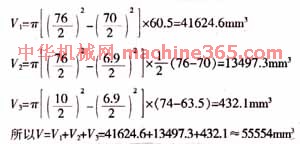|
|
|
说明:双击或选中下面任意单词,将显示该词的音标、读音、翻译等;选中中文或多个词,将显示翻译。
|
|
|
1) thin shell accessory

薄壳零件
2) complicated curved

板壳零件
3) shell parts

壳体零件
1.
With the comprehensive application of the numerical control machine tools,small shell parts cavity are more and more adopted by manufacturing corporations.
0调用SolidWorks为其提供的API(应用程序接口)功能进行针对小型壳体零件的二次开发。
4) thin-walled part

薄壁零件
1.
Based on it,a dynamic force model for milling process of thin-walled parts is established using a two-freedom elastic-damping system by considering the dynamic characteristics of the tool subsystem and the workpiece subsystem.
在此基础上,采用两自由度弹性-阻尼系统,建立了适合薄壁零件的综合考虑刀具子系统和工件子系统动态特性的动态铣削力模型。
5) Thin-wall parts

薄壁零件
1.
This paper analyses the relation between the cutting force and cutting depth in the course of belt grinding,builds the mathematics model of optimum cutting parameter to improve efficiency and intensity,and proposes the processing method for controlling griding precision of rotary thin-wall parts.
通过实验分析了带轮磨削过程中切削力和切削深度之间的关系,从提高切削效率和强度出发,选择优化切削参数,建立了切削参数数学模型;提出了控制回转形薄壁零件磨削精度的加工方
2.
As to the problem of cutting chatter found in the course of thin-wall parts milling,a theoretical model with regard to milling charter was established to conduct modal analysis experiments and milling experiments with a view to obtaining dynamic performance parameters of the system and milling force coefficient.
针对薄壁零件在铣削加工过程中存在的切削颤振问题,建立了铣削颤振理论模型,进行模态分析试验和铣削加工试验,获取系统动态性能参数和铣削力系数。
3.
The causes of deformation,size out-of-tolerance and collidings of the annular thin-wall parts produced by copper alloy extrusion materials are analyzed,and through production experiment,the reasonable process has be determined,which can reduce the production cost and improve product quality.
分析了利用铜合金挤压材加工环状薄壁零件生产过程中产生变形、尺寸超差、磕碰的原因,并通过生产实验确定了合理的加工工艺路线,降低了生产成本,提高了产品质量。
6) thin-walled component

薄壁零件
1.
To investigate the vibration principle in machining thin-walled components, a dynamic model for end milling of flexible structures is built based on considering the variations in the dynamic chip thickness and the differences between up-milling and down-milling.
为研究薄壁零件加工的振动机理,本文在考虑动态切削厚度的变化以及顺铣和逆铣之间差别的基础上,建立了一个薄壁零件立铣的力学模型,并用两个铣削实例加以验证。
补充资料:壳体零件的复合挤压
[摘要]介绍了壳体事件的挤压复合成形工艺,分析了挤压加工与机加工两种加工方法的材料利用率,设计计算了壳体零件的挤压件田,并设计了模具结构。
[关键词]:壳体零件;复合挤压模;材料利用率
军工产品壳体零件如图1所示,该零件外径的尺寸精度为O.12mm,表面粗糙度要求较高,零件材料为高强度硬铝2A12。其成份为:铜3.9%-4.8%;镁1.2%-1.6%;锰O.3%-O.9%;其余为铝。这种材料可以进行热处理强化,有较高的强度和耐热性。
该零件如果用机加工制造.不仅需要添置较多的机加工设备,而且加工时间长,浪费材料。采用挤压加工工艺不仅流程简单,生产操作方便,而且金属的力学性能良好。 可以把该零件分为上、中、下3段圆环,用 ,分别表示上、中、下3段圆环的体积。该零件总的体积V为: ,分别表示上、中、下3段圆环的体积。该零件总的体积V为: 

如果该零件机加工,假定单边加工余量为1.5mm,应该采用∮79×77mm的坯料,其体积为377429mm3。如果采用挤压加工,需要坯料有良好的流动性,所以在挤压前需要对坯料进行软化退火处理。其具体的退火热处理过程为:加热至410℃,保温6h,炉冷到150℃然后再空冷,这样软化处理后的硬度为53HB。退火热处理后的坯料,投有时效硬化现象,对于以后的冷挤压工序有利。 该壳体零件呈上杯下杆型,可进行复合挤压成型。挤压件底部厚度可以达到设计要求,不再需要机加工,大大节省了材料和工作量。零件的杆部为M10mm螺纹,无法挤压成型,可以后续机加工。 另外,在设计挤压件时要注意增加MlOmm杆部直径。因为如杆部太细,即使挤压件挤压成功,挤压件被顶料杆顶出时,也会在顶料力的作用下严重变形,使产品不合格。将杆部适当放粗至∮16mm。杆部的内孔直径为∮6.9mm,不宜挤压成型。因为如凸模工作部份顶墙尺寸太小,在挤压过程中容易断裂。 由于金属的各向异性,杯口部分不一定平整,所以要在杯的高度留加工余量1.5mm,以保证零件的外形尺寸。 挤压件如图2所示。 
说明:补充资料仅用于学习参考,请勿用于其它任何用途。
参考词条
|






 ,分别表示上、中、下3段圆环的体积。该零件总的体积V为:
,分别表示上、中、下3段圆环的体积。该零件总的体积V为:

